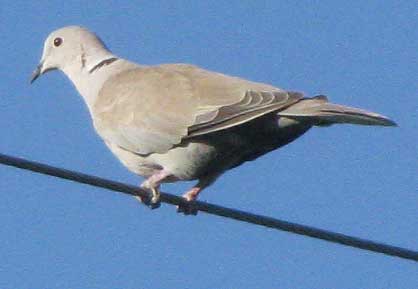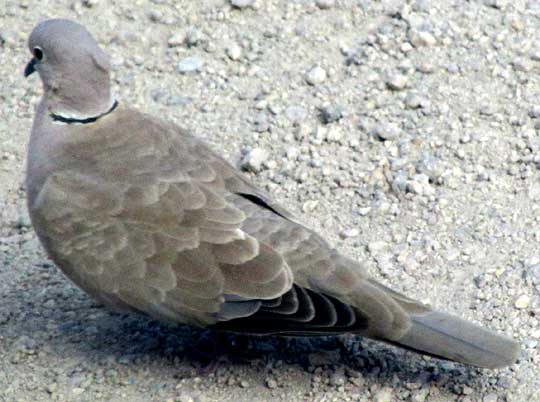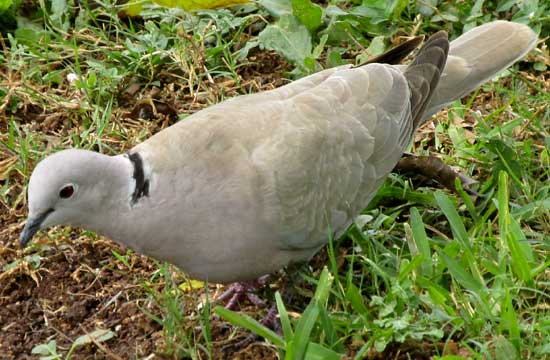Excerpts from Jim Conrad's
Naturalist Newsletter
from the September 16, 2012 Newsletter issued from the valley of the Dry Frio River in northern Uvalde County, southwestern Texas, on the southern border of the Edwards Plateau; elevation ~1750m (~5750 ft); N29.62°, W99.86°; USA
EURASIAN COLLARED DOVES
One of the first sounds catching my attention when I arrived here was a certain soft but guttural rrrrrrrrrrr which seemed very familiar but completely out of place in southwestern Texas. It was the call of the Eurasian Collared Dove, STREPTOPELIA DECAOCTO -- which I strongly associate with chilly, often rainy spring mornings during past lives in Germany and Belgium, where such calls often issued from trees and bushes. Hearing them wasn't a complete surprise because for years wild Eurasian Collared Doves have been turning up here and there all across the US. About five years ago my uncle in Owensboro, Kentucky told me that one day several appeared at his feeder. Still, I hadn't expected them in such an isolated spot as Uvalde County, southwestern Texas. You can see that they're really here below:

That black collar around the back of the neck and its whitish underparts make it easy to identify. However, there's another species, the Ringneck Dove, Streptopelia risoria, often kept in cages and sometimes escaped into the wilds, that's practically identical. However, it's the Eurasian Collared Dove spreading across America so explosively, so I assume that that's what our picture shows. I suspect that Eurasian Collared Doves have been released here intentionally because they are larger than all other local doves and some people like to hunt and eat them. In Texas you need a hunting license to shoot them but since they're an invasive species there's no closed season on them and no bag limit.
A century ago Eurasian Collared Doves occurred mainly on the Indian subcontinent, Turkey and the Balkans. In the early 20th century they expanded across Europe and North Africa, and by the mid-1950s they'd reached Great Britain and Norway. In the US they arrived in southern Florida in the early 1980s and by 1995 were found throughout the US Southeast. The first free-flying, Eurasian Collared Doves in Texas were spotted in 1995.
So far no studies indicate that Eurasian Collared Doves are significantly displacing native species, though in some places they do out-compete and replace other invasive dove species.
from the January 18, 2015 Newsletter issued from Río Lagartos, on the north-central coast of Yucatán, MÉXICO
EURASIAN COLLARED DOVES IN MEXICO
Back in arid southwestern Texas I was surprised to find Eurasian Collared Doves, STREPTOPELIA DECAOCTO, firmly established along the Dry Frio River. Now I've been surprised again to find them well established here in Río Lagartos on the Yucatan's northern coast. Below, you can see one taking his daily morning stroll on the pavement outside my door:

Those who have been paying attention to the amazingly fast spread of Eurasian Collared Doves in the Americas won't find this at all surprising.
They were documented in Yucatán state as early as 2010, and even earlier in other Mexican states; By 2006 they'd been documented in Sinaloa, Oaxaca, Jalisco, Veracruz and other states. A study in Yucatán state in 2011 found them mostly in the northwestern corner of the state, with none reported from the Río Lagartos area.
Other non-native birds that can be seen nowadays in Yucatán state include Pigeons, Starlings, House Sparrows and the Tricolor Munia, the latter similar to a grosbeak.
from the March 11, 2018 Newsletter issued from Rancho Regenesis in the woods ±4kms west of Ek Balam Ruins, central Yucatán, MÉXICO
EURASIAN COLLARED DOVES IN VALLADOLID
Last week in the big central park in Valladolid I heard a certain cooing reminding me of my days in Europe, looked onto the ground behind my bench, and saw the Eurasian Collared Dove shown below:

When we were in southwestern Texas some chatting hunters had said that originally in that area there had just been Mourning Doves. When south Texas's citrus plantations were wiped out, White-winged Doves that had nested in the citrus orchards had moved north, somewhat displacing Mourning Doves. And now recently arrived Eurasian Collared Doves were displacing White-winged Doves.
I'm not sure that that's true, though I did see the Eurasian Collared Dove in Valladolid doing something interesting that might fit into the narrative. First, the ones in the park didn't react when I tossed small pieces of tortilla near them, though the resident pigeons eagerly showed them what to do with such a snack. Also, when a White-winged Dove discovered another kind of edible tidbit on the park sidewalk and began pecking at it, an Eurasian Collared Dove flew at it and took the food away.